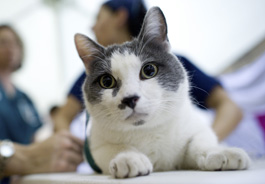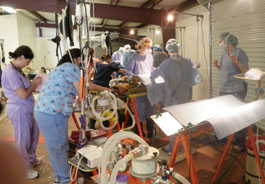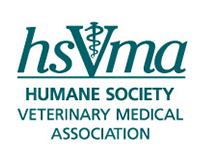HSVMA-RAVS: Experiences You Won't Get in a Classroom
by Karyn Carlson November 27, 2012  Each dog and cat visiting an HSVMA-RAVS clinic receives an exam, vaccinations, deworming medicine (if needed) flea and tick preventative, and spay/neuter surgery – all free of charge. Davis Paul Morris for The HSUS On just the second night of my first trip with HSVMA’s Rural Area Veterinary Services (HSVMA-RAVS), it was announced at 10 p.m. that a dog who had been spayed earlier that day was going to have to be returned to surgery to address a complication, and I thought I was nuts for signing up for this. I knew that sleep would be scarce since I had received a fair warning from reading the RAVS website but, as a veterinary student, I thought it would be nothing compared to the hellacious nights of studying during midterms and finals. I was wrong, and this was just the beginning of my amazing adventure. The morning of the first day in Bylas, Ariz., the parking lot was packed by 7 a.m. Systematically, each family and their animals were seen by a team of two veterinary students. Each dog and cat was evaluated with a physical exam, vaccinated, dewormed, treated for fleas and ticks, and admitted for spay or neuter surgery. It gets hot early in Arizona; the temperature reached more than 100 degrees and we were out in the relentless sun with families who had been waiting patiently for our services. We worked non-stop until all the dogs and cats were admitted for surgery. A team of student surgeons worked one-on-one with supervising veterinarians performing spays and neuters. Then the receiving teams evaluated each animal post-surgery and discharged them to their families. This continued until 10 p.m. That first day set the tone for the rest of the trip. The remaining clinic days were in San Carlos, Ariz. We worked in a Boys & Girls Club and we slept in a nearby gym that had showers, which can be a luxury on RAVS trips! Each day, students rotated through receiving, anesthesia, and surgery, participating in all aspects of caring for the dogs and cats of the community. In rounds I learned that the people of the San Carlos Reservation face a particularly unique and troubling situation. Rocky Mountain Spotted Fever (RMSF) is a disease carried by Dermacenter and Rhipacephalus ticks, which infect both people and dogs and is fatal if not treated promptly. RMSF has resulted in a number of deaths of San Carlos community members. RAVS has been helping the community battle the disease by treating dogs with a monthly tick preventative, spaying and neutering animals to help decrease the population of tick-spreading dogs that roam the area, and treating ill dogs with doxycycline. The community was very vocal about how much they appreciated our services.  The RAVS team in action. Meghan Cavanaugh The trip was life-changing for me. Most of the dogs and cats live outside and are not allowed indoors because they are so tick-infested that it is a real health risk to bring them into the home. Many owners are unable to afford food for their pets, and feeding them more than once a day is not possible. Despite difficult circumstances, I spoke to families who wanted to know what they could do about the tartar on their animals’ teeth or the luxating patellas that were mentioned in my physical exam; they would do anything for their pets, even if it meant skipping groceries for themselves. This trip redefined the human-animal bond in my mind, and made me rethink any assumptions or judgments I may have had about reservation life. The dogs and cats were something spectacular in their own right. As each animal was examined and cared for, it was almost as if I could feel their appreciation. Most of the animals were compliant and readily allowed me to examine and treat them. Each of them came with their own story that was told through scars, old fractures, or other obvious injuries. Many of the dogs and cats were survivors of major trauma – sometimes human inflicted – for which they never received veterinary care as it was not economically or geographically accessible. I felt honored to be able to care for these stoic animals who lived through so much and, even if their past was darkened by the inhumanity of people’s actions, their eyes were still kind as they looked beyond the invasiveness of our preventative care treatments. The days on a RAVS trip are long and the nights are short. I felt like I had been hit by a freight train when I got up each morning because I was both physically- and mentally- exhausted, but I say without hesitation, I wouldn’t have traded an hour of sleep for anything because the hours I spent with the amazing people of the Apache tribe and their animals was so rewarding, AND FUN! The trip ended with a “thank you” dinner at the local casino, paid for by the San Carlos Apache Tribe. We were each given a hand-made gift from tribal members who thanked us from the bottom of their hearts with tears in their eyes. It was clear to me that our actions on the San Carlos Reservation not only improved the quality of life for many animals, but were also life saving for the people of the Apache Nation.
 Ashleigh Allen Karyn Carlson is a third year veterinary student (Class of 2014) at the University of Prince Edward Island-Atlantic Veterinary College in Charlottetown, Prince Edward Island, Canada and an HSVMA member. After graduation, Karyn hopes to return to her hometown of Tucson, Ariz. with her fiance, Justin, and their five dogs, to pursue a career in shelter medicine. |
